|
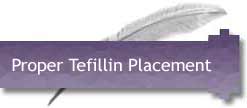
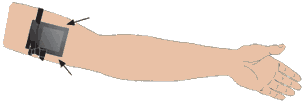
The Bayis shel yad must rest on the center of the width of the
biceps muscle of the weaker arm leaning slightly toward the heart.
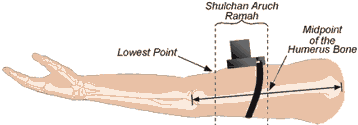
According to the Shulchan Aruch and the Rama, no part of
the bayis shel yad may rest any higher than the midpoint of the
humerus bone.
According to
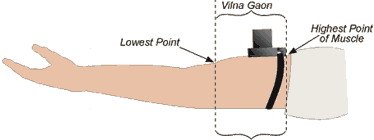 the Vilna Gaon, the bayis shel yad may rest anywhere on the
biceps muscle. Consult your rabbi. The bayis shel yad must not
rest below the lower point of the biceps muscle. the Vilna Gaon, the bayis shel yad may rest anywhere on the
biceps muscle. Consult your rabbi. The bayis shel yad must not
rest below the lower point of the biceps muscle.
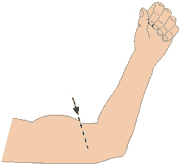
Some say that the lowest edge of the biceps muscle is determined when
the arm is outstretched and relaxed. Others say that the lowest edge of
the biceps muscle is determined when the arm is bent at approximately
90°. Consult a rabbi which opinion to follow.
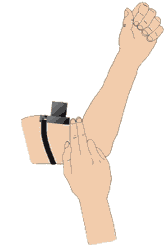 Verify
that the bayis is not positioned too low by locating the base of
the muscle with one's finger and making sure that the front edge of the
base is above it. If one can place the pinky, ring, and middle fingers
between the cleft of the arm and the front edge of the base while the
arm is outstretched, then it is most likely in the proper position according
to the opinion that the base of the muscle is determined when the arm
is outstretched and relaxed. If one can place the index and middle finger
between the cleft of the arm and front edge of the base while the arm
is bent at approximately 90° then it is most likely in the proper
position according to the opinion that the base of the muscle is determined
when the arm is bent at approximately 90°. Verify
that the bayis is not positioned too low by locating the base of
the muscle with one's finger and making sure that the front edge of the
base is above it. If one can place the pinky, ring, and middle fingers
between the cleft of the arm and the front edge of the base while the
arm is outstretched, then it is most likely in the proper position according
to the opinion that the base of the muscle is determined when the arm
is outstretched and relaxed. If one can place the index and middle finger
between the cleft of the arm and front edge of the base while the arm
is bent at approximately 90° then it is most likely in the proper
position according to the opinion that the base of the muscle is determined
when the arm is bent at approximately 90°.
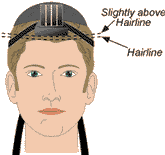
The entire bayis
shel rosh must rest above the original hairline, which is determined
by the hair's roots. It's suggested to allow a finger's width of leeway.
One whose hairline has receded should continue to place the bayis shel
rosh above his original hairline, even though hair no longer grows
there.
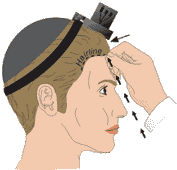
Feel along the hairline
with the length of the index finger or with the tips of his fingers to
verify that the bayis is resting above it.
  
Draw the index finger and pinky or the index finger and thumb from the
sides of the base down to the eyes to verify that the bayis is
centered.
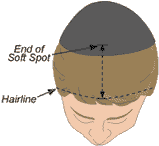
The back edge of
the bayis can reach until the top of the head, which is equivalent
to the end of the soft spot on a baby's head. 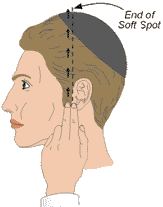
Identify this point
by running the tip of a finger straight up from the front of the ear.
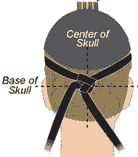
The majority of the
knot must rest on the center of the base of the skull. The remainder of
the knot may rest just below it in the indentation on the nape.
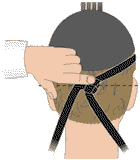 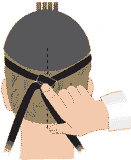 Verify
that the majority of the knot is resting on the base of the skull by pressing
on the upper part of the knot. If one feels the small, round, protruding
bone when pressing, then the knot is in position. If by pressing on the
lower part of the knot one feels that it's in the indentation of the neck,
then that verifies that it's centered. Verify
that the majority of the knot is resting on the base of the skull by pressing
on the upper part of the knot. If one feels the small, round, protruding
bone when pressing, then the knot is in position. If by pressing on the
lower part of the knot one feels that it's in the indentation of the neck,
then that verifies that it's centered.
|



 the Vilna Gaon, the bayis shel yad may rest anywhere on the
biceps muscle. Consult your rabbi. The bayis shel yad must not
rest below the lower point of the biceps muscle.
the Vilna Gaon, the bayis shel yad may rest anywhere on the
biceps muscle. Consult your rabbi. The bayis shel yad must not
rest below the lower point of the biceps muscle.
 Verify
that the bayis is not positioned too low by locating the base of
the muscle with one's finger and making sure that the front edge of the
base is above it. If one can place the pinky, ring, and middle fingers
between the cleft of the arm and the front edge of the base while the
arm is outstretched, then it is most likely in the proper position according
to the opinion that the base of the muscle is determined when the arm
is outstretched and relaxed. If one can place the index and middle finger
between the cleft of the arm and front edge of the base while the arm
is bent at approximately 90° then it is most likely in the proper
position according to the opinion that the base of the muscle is determined
when the arm is bent at approximately 90°.
Verify
that the bayis is not positioned too low by locating the base of
the muscle with one's finger and making sure that the front edge of the
base is above it. If one can place the pinky, ring, and middle fingers
between the cleft of the arm and the front edge of the base while the
arm is outstretched, then it is most likely in the proper position according
to the opinion that the base of the muscle is determined when the arm
is outstretched and relaxed. If one can place the index and middle finger
between the cleft of the arm and front edge of the base while the arm
is bent at approximately 90° then it is most likely in the proper
position according to the opinion that the base of the muscle is determined
when the arm is bent at approximately 90°.








 Verify
that the majority of the knot is resting on the base of the skull by pressing
on the upper part of the knot. If one feels the small, round, protruding
bone when pressing, then the knot is in position. If by pressing on the
lower part of the knot one feels that it's in the indentation of the neck,
then that verifies that it's centered.
Verify
that the majority of the knot is resting on the base of the skull by pressing
on the upper part of the knot. If one feels the small, round, protruding
bone when pressing, then the knot is in position. If by pressing on the
lower part of the knot one feels that it's in the indentation of the neck,
then that verifies that it's centered.
